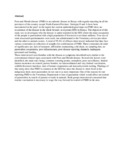Factors Leading To Lack Of Confirmation And Under-Reporting Of Foot-And-Mouth Disease In The Somali- Ecosystem In Kenya

View/
Date
2010-08Author
Chepkwony, E C
Gitao, G C
Muchemi, G M
Language
enMetadata
Show full item recordAbstract
Foot-and-Mouth disease (FMD) is an endemic disease in Kenya with regular reporting in all the provinces of the country except North-Eastern Province. Serotype O and A have been encountered in the past1 in the region but current epidemiological maps on FMD show no occurrence of the disease in the whole Somali- ecosystem (SES) in Kenya. The objective of this study was to investigate why the disease is under-reported in the SES where the main occupation of the people is pastoralism with a high population of livestock (over three million). Two sets of semi-structured questionnaires were used, one administered to the Veterinary service providers and the other to animal owners. A total of 95.4% of officers interviewed indicated that they face various constraints in collection of samples for confirmation of FMD. These constraints in order of significance are; lack of transport, difficulties maintaining cold chain, no sampling kits, no pastoralists cooperation, poor infrastructure, poor disease reporting channels, inadequate personnel and funding.
Those interviewed were familiar with the disease as symptoms described were similar to the conventional clinical signs associated with Foot-and-Mouth disease. Several risk factors were identified, the main ones being: common watering points, nomadism, poor surveillance, limited farmer awareness on control, porous borders, no /uncoordinated and very limited vaccination, wildlife-livestock interface, lack of farmer cooperation and insecurity/cattle rustling. Findings of this study show that FMD is common in the SES but since the disease is short-lived in the indigenous herd, most pastoralists do not rate it as most important. One of the reasons for not reporting FMD to the Veterinary Department is fear of quarantine which would affect movement of pastoralists in search of pasture or trade in animals. Both groups interviewed concurred that routine vaccination is necessary to wage the way forward in control of FMD in the area.
Citation
Chepkwony,E.C.,Gitao,G.C.,Muchemi,G.M.,September,2010.Factors Leading To Lack Of Confirmation And Under-Reporting Of Foot-And-Mouth Disease In The Somali- Ecosystem In Kenya,Presentation at the Proceedings Of The 7th Biennial Scientific Conference September 8th To 10th 2010.Publisher
University of Nairobi
